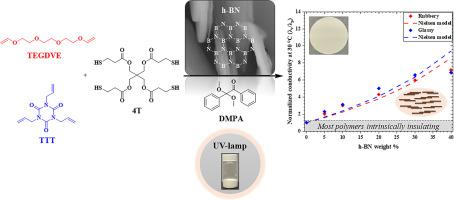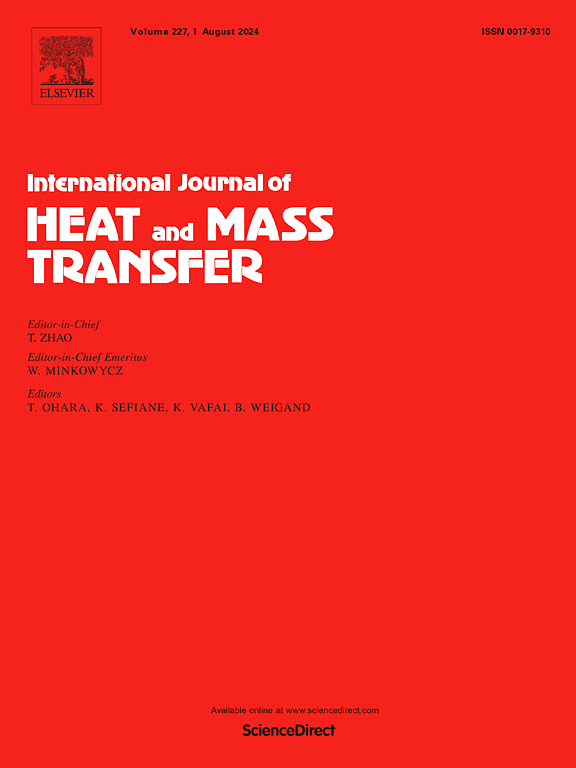增强填充了六方氮化硼的可光聚合橡胶和玻璃状硫醇烯复合材料的导热性能
IF 5
2区 工程技术
Q1 ENGINEERING, MECHANICAL
International Journal of Heat and Mass Transfer
Pub Date : 2024-11-16
DOI:10.1016/j.ijheatmasstransfer.2024.126431
引用次数: 0
摘要
本研究展示了一种简便快捷的方法来制造含有六方氮化硼(h-BN)的高导热聚合物复合材料。通过将未经改性的 h-BN 微颗粒与不同的液态硫醇和烯单体进行机械混合,然后用紫外线固化铸膜,制得了室温下呈橡胶和玻璃状的硫醇烯基复合材料。复合材料的热扩散率是用光闪分析仪(LFA)直接测量的,而热导率则是根据热扩散率、密度和恒压下的热容量计算得出的。扫描电子显微镜(SEM)用于研究复合材料的形态,特别是颗粒的取向和空间排列。在通过机械混合制备的复合材料中,橡胶硫醇烯基复合材料和玻璃硫醇烯基复合材料都表现出极高的热导率。例如,含 40 wt% h-BN 的橡胶基和玻璃基复合材料的热导率分别为 1.38 W/m-K 和 0.74 W/m-K,而未填充网络的热导率分别为 0.19 W/m-K 和 0.11 W/m-K。热导率与 h-BN 含量的实验数据与尼尔森模型进行了拟合,结果显示两者吻合良好。但该模型中唯一与颗粒长宽比相关的拟合参数却大于根据 h-BN 填充物实际尺寸计算得出的参数。扫描电镜数据揭示了这一行为。h-BN 相均匀分散,主要由微小的聚集体组成,其中堆积的小板表现出单向滑动,就像楼梯上的台阶,从而形成了纵横比增大的准颗粒。研究还揭示了 h-BN 粒径和加工条件对复合材料热导率的影响,例如在光聚合之前添加少量溶剂以降低硫醇/烯/h-BN 混合物的粘度。本文章由计算机程序翻译,如有差异,请以英文原文为准。

Enhanced thermal conductivity of photopolymerizable rubbery and glassy thiol-ene composites filled with hexagonal boron nitride
In this study, a facile and speedy method of making highly thermally conductive polymer composites containing hexagonal boron nitride (h-BN) was demonstrated. Rubbery and glassy at room temperature thiol-ene based composites were fabricated by mechanical mixing of unmodified h-BN microparticles with different liquid thiol and ene monomers followed by UV-curing of the cast films. Thermal diffusivity of the composites was directly measured by a Light Flash Analyzer (LFA) while thermal conductivity calculated from thermal diffusivity, density, and thermal capacity at constant pressure. Scanning electron microscopy (SEM) was used to investigate the morphology of the composites, in particular, the particle orientation and spatial arrangement. Both rubbery and glassy thiol-ene based composites exhibited very high levels of thermal conductivity for the composites prepared via mechanical mixing. For instance, the thermal conductivity of the rubbery and glassy composites with 40 wt% of h-BN were 1.38 W/m·K and 0.74 W/m·K as compared to 0.19 W/m·K and 0.11 W/m·K for the unfilled networks, respectively. The thermal conductivity versus h-BN content experimental data were fit to the Nielsen model which showed a good agreement. But the only fitting parameter of the model, which is related to the particle aspect ratio, turned out to be greater than the calculated one based on the real dimensions of h-BN filler. The SEM data have shed light on this behavior. The h-BN phase was uniformly dispersed and mainly made of tiny aggregates in which the stacked platelets demonstrated one way sliding, like steps in a staircase, thus forming quasiparticles with an increased aspect ratio. The study also revealed the effect of h-BN particle size and processing conditions such as adding a small amount of solvent used to reduce viscosity of the thiol/ene/h-BN mixture prior to photopolymerization on the thermal conductivity of the composites.
求助全文
通过发布文献求助,成功后即可免费获取论文全文。
去求助
来源期刊
CiteScore
10.30
自引率
13.50%
发文量
1319
审稿时长
41 days
期刊介绍:
International Journal of Heat and Mass Transfer is the vehicle for the exchange of basic ideas in heat and mass transfer between research workers and engineers throughout the world. It focuses on both analytical and experimental research, with an emphasis on contributions which increase the basic understanding of transfer processes and their application to engineering problems.
Topics include:
-New methods of measuring and/or correlating transport-property data
-Energy engineering
-Environmental applications of heat and/or mass transfer

 求助内容:
求助内容: 应助结果提醒方式:
应助结果提醒方式:


